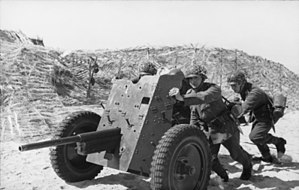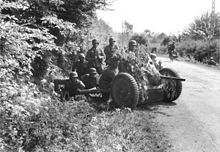3.7 cm Pak 36
This article includes a list of references, related reading, or external links, but its sources remain unclear because it lacks inline citations. (September 2009) |
This article or section possibly contains synthesis of material which does not verifiably mention or relate to the main topic. (September 2009) |
| 3.7 cm Pak 36 | |
|---|---|
 3.7 cm Pak 36 | |
| Type | Anti-tank gun |
| Place of origin | |
| Service history | |
| Used by | |
| Wars | Chinese Civil War Spanish Civil War World War II |
| Production history | |
| Designer | Rheinmetall |
| Manufacturer | Rheinmetal |
| Unit cost | 2,579$ |
| Specifications | |
| Mass | travelling 450 kg (970 lb)/action 327 kg (723 lb) |
| Length | 1.66 m (5.44 ft) |
| Width | 1.65 m (5.44 ft) |
| Height | 1.17 m (3.83 ft) |
| Diameter | 37 mm |
| Crew | 2 |
| Shell | 37 × 249 mm. R |
| Caliber | 37 mm (1.45 in) L/45 |
| Barrels | 65.5 in |
| Elevation | -5° to +25° |
| Traverse | 30° degrees right and left |
| Rate of fire | 13 rpm |
| Muzzle velocity | 762 m/s (2,500 ft/s) |
| Effective firing range | 300 m (328 yds) |
| Maximum firing range | 5,484 m (5,997 yds) |

The Pak 36 (Panzerabwehrkanone 36) was a German anti-tank gun that fired a 3.7 cm calibre shell. Design of a horse-drawn, 3.7 cm anti-tank gun (designated 3.7 cm Pak L/45) by Rheinmetall commenced in 1924 and the first guns were issued in 1928[2]. By the early 1930s, it was apparent that horse-drawn artillery was obsolescent, and the gun was modified for motorized transport by substituting magnesium-alloy wheels and pneumatic tyres for the original spoked wooden wheels. Re-designated the 3.7 cm Pak 35/36, it began to replace the 3.7 Pak L/45 in 1934 and first appeared in combat in 1936 during the Spanish Civil War. It formed the basis for many other nations' anti-tank guns during the first years of World War II. The KwK 36 L/45 was the same gun but was used as the main armament on several tanks, most notably the early models of the Panzer III. It was employed by Finnish troops during World War II, notably during the Defense of Suomussalmi.
The Pak 36, being a small-calibre weapon, was outdated by the May 1940 Western Campaign, and crews found them all but useless against heavy allied tanks like the British Mk.II Matilda and the French Char B1 and Somua S35. A group of these guns claimed to have knocked out a Char B1 by firing at its flank. The Pak 36 can penetrate 35 mm sloped armor at 30 degrees. The Char B1's side armor was 40 mm. However, it was vertical. Thus it could be penetrated by Pak 36 only when fired within 100 m and at a right angle from the side armor. This was very difficult to achieve in battlefield conditions. Still, the gun was effective against the most common Allied pre-war light tanks, such as the FT-17 during the Battle of France and the T-26 during Operation Barbarossa. The widespread introduction of medium tanks quickly erased the gun's effectiveness; miserable performance against the T-34 on the Eastern Front led to the Pak 36 being derisively dubbed the "Door Knocker" ("Heeresanklopfgerät", literally "army door knocking device") for its inability to do anything other than advertise its presence to a T-34 by futilely bouncing rounds off its armor.
The Pak 36 began to be replaced by the new 5cm Pak 38 in mid 1940. The addition of tungsten cored shells added slightly to the armour penetration of the Pak 36. Despite its continued impotence against the T-34, it remained the standard anti-tank weapon for many units until 1942. It was discovered that Pak 36 crews could still achieve kills on T-34s, but the feat required tungsten-cored armour piercing ammunition and a direct shot to the rear or side armor from point-blank range.
As the Pak 36 was gradually replaced, many were removed from their carriages and added to Halftracks to be used as light anti-armour support. The guns were also passed off to the forces of Germany's allies fighting on the Eastern Front, such as the 3rd and 4th Romanian Army. This proved particularly disastrous during the Soviet encirclement operation (Operation Uranus) at the Battle of Stalingrad when the nearly-defenseless Romanian forces were targeted to bear the main Soviet armored thrust. The Pak 36 also served with the armies of Finland, Hungary and Slovakia. In 1943, the introduction of the Stielgranate 41 shaped charge meant that the Pak 36 could now penetrate any armour, but only at a range of less than 300 meters. The Pak 36s, together with the new shaped charges, were issued to Fallschirmjäger units and other light troops. The gun's light weight meant that it could be easily moved by hand, and this mobility made it ideal for their purpose.
37mm Pak 36 L/45 ammunition
- Pzgr
- Projectile weight: 0,685 kg
- Muzzle velocity: 745 m/s
- Pzgr 40
This was tungsten cored ammunition, lighter and with higher muzzle velocity, produced in small quantities.
- Projectile weight: 0,368 kg
- Muzzle velocity: 1,020 m/s
| Range | Penetration | in training | in combat |
|---|---|---|---|
| 100 m | 64 mm | 100 % | 100 % |
| 500 m | 31 mm | 100 % | 100 % |
| 1000 m | 22 mm | 100 % | 85 % |
| 1500 m | 20 mm | 95 % | 61 % |
| 2000 m | - mm | 85 % | 43 % |
Penetration figures given for Pzgr 40 and an armoured plate 30 degrees from the horizontal.
Notes
- ^ Jowett, Philip. The Chinese Army 1937-49: World War II and Civil War. Osprey Publishing. p. 16. ISBN 1-84176-904-5.
- ^ Terry Gander and Peter Chamberlain, Small Arms, Artillery and Special Weapons of the Third Reich, MacDonald and Janes, London, 1978, p107.
References
- Gander, Terry and Chamberlain, Peter. Weapons of the Third Reich: An Encyclopedic Survey of All Small Arms, Artillery and Special Weapons of the German Land Forces 1939-1945. New York: Doubleday, 1979 ISBN 0-385-15090-3
- Hogg, Ian V. German Artillery of World War Two. 2nd corrected edition. Mechanicsville, PA: Stackpole Books, 1997 ISBN 1-85367-480-X
External links
